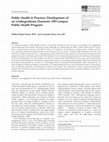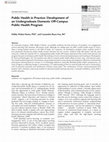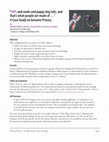Papers by Debby Walser-kuntz

Journal of Immunology, May 1, 2018
The rapidly changing nature of immunology makes it a challenging course for both undergraduate st... more The rapidly changing nature of immunology makes it a challenging course for both undergraduate students and faculty. A teaching approach that incorporates essential immunological techniques and an introduction to the primary literature helps undergraduates navigate the discipline and remain current. Case studies are an effective active learning approach that provide real world examples to engage undergraduates and an opportunity for hands on problem solving, data analysis, and critical thinking as students must consider outcomes and consequences. Although case studies that explore clinical connections already exist for undergraduates, they do not include key techniques or provide experience working with the primary literature. We have developed several case studies to help undergraduate immunology students understand and analyze data involving: flow cytometry, CRISPR/Cas, CAR T cells, and ELISAs. The case studies 1) introduce students to techniques and methods they may not have access to in their laboratory courses due to the lack of appropriate instruments or the cost of reagents, 2) build on difficult concepts covered in the course, and 3) incorporate figures from papers that challenge students to apply what they have learned. Assessment of student learning includes in-class quizzes and small group responses to data analysis questions, the use of “clickers”/personal response system, and related exam questions. Students self-report that the case studies are a highly effective teaching method that allow them to both reinforce their understanding of the course material and apply it to practical problems.

The Journal of Immunology
The rapidly changing nature of immunology makes it a challenging course for both undergraduate st... more The rapidly changing nature of immunology makes it a challenging course for both undergraduate students and faculty. A teaching approach that incorporates essential immunological techniques and an introduction to the primary literature helps undergraduates navigate the discipline and remain current. Case studies are an effective active learning approach that provide real world examples to engage undergraduates and an opportunity for hands on problem solving, data analysis, and critical thinking as students must consider outcomes and consequences. Although case studies that explore clinical connections already exist for undergraduates, they do not include key techniques or provide experience working with the primary literature. We have developed several case studies to help undergraduate immunology students understand and analyze data involving: flow cytometry, CRISPR/Cas, CAR T cells, and ELISAs. The case studies 1) introduce students to techniques and methods they may not have acce...
for “SNPs and snails and puppy dog tails, and that’s what people are made of …”
This case study teaches students the basics of flow cytometry instrumentation and data interpreta... more This case study teaches students the basics of flow cytometry instrumentation and data interpretation. Flow cytometry is a fundamental technique used by immunologists, and I use this case study in the junior/senior level majors

Taylor goes in to see her doctor, Dr. Chavez, for an annual exam and, when asked, admits that she... more Taylor goes in to see her doctor, Dr. Chavez, for an annual exam and, when asked, admits that she has been feeling tired and has had several colds recently. Since she works full-time and has two young children, she didn’t think these symptoms unusual. However, her meticulous doctor notices swollen lymph nodes in her neck and decides to draw blood to perform a white blood cell count. Taylor gets a call from her doctor the next day with the news that her white blood cell count shows an elevated number of lymphocytes. At her return appointment, Taylor is told by Dr. Chavez that she needs to have more blood drawn and that this time the blood will be tested using a more sophisticated test called flow cytometry. When asked why, the doctor replies that flow cytometry is a common test for chronic lymphocytic leukemia, or CLL, a cancer typically affecting older adults. CLL is characterized by a slow increase in the number of lymphocytes, most often the B lymphocytes, the antibodyproducing ce...
Libraries can serve as a site for student-curated, curricular exhibitions that provide an opportu... more Libraries can serve as a site for student-curated, curricular exhibitions that provide an opportunity for public scholarship and an extension of service learning. Exhibit design challenges science students to translate their learning into a compelling story both visually and through text accessible to non-specialists. In this active learning session, a library curator and biology professor will briefly share their experience collaborating to support a student-curated exhibition in an undergraduate service learning public health course. Participants will collectively curate a mini-exhibition, providing perspective on synthesizing, selecting, and summarizing a complex topic for the public, with time included for reflection and discussion

The prevalent use of bisphenol-A (BPA) in food containers, thermal paper, and other products prov... more The prevalent use of bisphenol-A (BPA) in food containers, thermal paper, and other products provides an environmental challenge to the immune system of both humans and wildlife as BPA disrupts estrogen activity and alters signaling. We are exploring the impact of in vivo BPA exposure on innate immunity in both mice and zebrafish. Our earlier work in C57BL/6J mice showed that low dose, in vivo BPA exposure significantly decreases LPS-induced expression of CXCL-1, a chemokine that recruits neutrophils to the site of infection and the mouse homolog of human IL-8, in spleen cells. To determine if reduced chemokine secretion has a functional outcome, we expanded our studies to the zebrafish embryo model. Real time PCR analysis indicates that 4 to 6 day post fertilization (dpf) zebrafish exposed to environmentally relevant doses of BPA show reduced background expression of CXCL-8, the zebrafish homolog of mouse CXCL-1, and a reduction in the total number of neutrophils (4 dpf). BPA expos...

International Journal of Health Care Quality Assurance, 2003
More than a decade ago, the Institute of Medicine concluded that public health literacy is essent... more More than a decade ago, the Institute of Medicine concluded that public health literacy is essential for all citizens and recommended all U.S. undergraduates should have the opportunity to study public health . Another transformative initiative, the Association of American Colleges & Universities' Liberal Education and America's Promise (LEAP), supports a set of learning outcomes for undergraduates that encourages students to "engage in learning that seeks inter-and multidisciplinary answers to unscripted real-world problems" see also Calhoun, Ramiah, Weist, & Shortell, 2008). The field of public health is replete with such opportunities due to its inherent interdisciplinary nature; thus LEAP's learning outcomes integrate well with the study of public health . LEAP identified service learning, or academic civic engagement (ACE), as one of five high-impact teaching practices . Academic service learning experiences that follow widely accepted best practices (1) maintain academic rigor; (2) are reciprocal in nature, meeting an identified community need while also meeting stated learning goals; and (3) provide an opportunity for reflection to help students "gain further understanding of course content, a broader appreciation of the discipline, and an enhanced sense of civic responsibility" . Although the language used to describe service learning courses varies from campus to campus, at its core, evidence supports that learning with and in community "enhance[s] students' understanding of the relevance of course content," is "personally meaningful to participants," and has the potential to "change student . . . attitudes" . The inclusion of community-based projects as a means to support student engagement in complex, real-world issues aligns well with the high-impact teaching practices.

Pedagogy in Health Promotion, 2016
An innovative program, Public Health in Practice, successfully combines the best practices of aca... more An innovative program, Public Health in Practice, successfully combines the best practices of academic civic engagement (service learning) with domestic off-campus study. Although our college does not offer a public health major or minor, there is strong student interest in this field of study. As a response, we developed a program where students enroll in two sequential introductory public health courses; between the two courses, students study off-campus with the same instructor. Unlike the majority of U.S. undergraduate public health off-campus experiences that involve travel abroad, this program focused on domestic public health. By working on local community-based projects and traveling to Minneapolis/St. Paul and Washington, DC, the students were able to compare public health efforts at local, state, and national scales. Our mixed-methods approach of evaluation using student pre/post surveys along with integrative reflections indicated that participants demonstrated an increas...
Trends in Immunology, 2016
Although discussions to improve training for immunologists often focus on graduate programs, ther... more Although discussions to improve training for immunologists often focus on graduate programs, there are important reasons for teaching undergraduate immunology courses and several best practices utilized by undergraduate faculty. Here, we propose and outline steps for improved communication between undergraduate and graduate educators to enhance the training of future immunologists.

The Journal of Immunology, May 1, 2014
There is a growing recognition and sense of urgency that scientists need to be better equipped to... more There is a growing recognition and sense of urgency that scientists need to be better equipped to communicate scientific ideas to the general public. Improved communication is an opportunity with significant policy, behavior, and funding implications. For the past 5 years, I have integrated civic engagement projects into the upper-level Immunology course I teach at Carleton College - a small liberal arts college located in Northfield, MN - in order to provide an opportunity for students to practice translating complex, jargon-rich information into engaging materials for use in the local community. These projects are by nature reciprocal; they provide an authentic learning opportunity for students and a very real benefit for our community partners. Additional student outcomes include increased awareness of local public health issues, enhanced understanding of the connection between immunology and real world problems, and improved scientific communication skills, including in some cases, grant writing skills. Civic engagement projects range from writing grant proposals or research reports for local nonprofit organizations to performing “Immunology Theater” with at-risk high school students or developing comics and videos to teach about sexually transmitted diseases. Assessment of the effectiveness and impact of the civic engagement projects included alumni surveys (2009-2013 graduates; n=192), evaluation of student reflections, and community partner surveys.

The Journal of Immunology, May 1, 2014
The recent obesity epidemic has led to an expansion in our understanding of the link between adip... more The recent obesity epidemic has led to an expansion in our understanding of the link between adipose tissue and inflammation. The prevalent use of bisphenol-A (BPA) in food containers and other products provides an additional environmental challenge to the immune system. BPA disrupts the action of physiologic estrogens by binding to estrogen receptors and has previously been shown to impact immune responses. We explored the combined effects of high-fat diet and in vivo BPA exposure on spleen innate immune mediators. BPA treatment (2.5 or 25.0 ug/kg body weight per day; 4 weeks) reduced the LPS-induced secretion of KC chemokine, a neutrophil chemotaxin, by 25% and 40% respectively in normal diet mice, with a more dramatic BPA-induced decrease in KC secretion observed in high-fat fed mice. High-fat diet increased TNF-α mRNA expression overall compared to normal diet, and high dose-BPA reduced LPS-stimulated TNF-α mRNA expression in both normal (19%) and high-fat fed (34%) mice. High-fat fed mice also had a greater increase in LPS-induced COX-2 mRNA expression than normal diet mice, with BPA modulating expression in both groups in a dose dependent manner. High-fat diet and low dose BPA exposure increased non-fasting blood glucose levels by 30% on average when compared to control normal diet mice. These data demonstrate that peripubertal BPA exposure dampens aspects of innate immune function and that BPA combined with high-fat diet may disrupt glucose metabolism.

Journal of immunology (Baltimore, Md. : 1950), 1997
We have identified in an extracellular segment of the alpha1 subunit of nicotinic acetylcholine r... more We have identified in an extracellular segment of the alpha1 subunit of nicotinic acetylcholine receptor (AChR) of homologous muscle a 17-residue autoantigen that, without conjugation to a carrier, activates Th lymphocytes and induces production of autoantibodies that cause electrophysiologic signs of experimental autoimmune myasthenia gravis. A panel of overlapping synthetic peptides revealed two T cell epitopes, one encompassed by residues 121-136 and the other by 129-145. Residues 129 (glutamic acid) and 130 (isoleucine) were implicated in a pathogenic B cell epitope. Peptide 129-145 (Glu-Ile-Ile-Val-Thr-His-Phe-Pro-Phe-Asp-Glu-Gln-Asn-Cys-Ser-Met-Lys, a conserved sequence in rat and human AChR) induced autoantibody production in 76% of rats. All seropositive rats had evidence of experimental autoimmune myasthenia gravis; five of five tested had electrophysiologic signs, and all had loss of immunochemically measured autologous muscle AChR. Analogues of 129-145, with single residu...
Reproductive Toxicology, 2007

Reproductive Toxicology, 2007
Concern is mounting regarding the human health and environmental effects of bisphenol A (BPA), a ... more Concern is mounting regarding the human health and environmental effects of bisphenol A (BPA), a high-production-volume chemical used in synthesis of plastics. We have reviewed the growing literature on effects of low doses of BPA, below 50 mg/(kg day), in laboratory exposures with mammalian model organisms. Many, but not all, effects of BPA are similar to effects seen in response to the model estrogens diethylstilbestrol and ethinylestradiol. For most effects, the potency of BPA is approximately 10-1000-fold less than that of diethylstilbestrol or ethinylestradiol. Based on our review of the literature, a consensus was reached regarding our level of confidence that particular outcomes occur in response to low dose BPA exposure. We are confident that adult exposure to BPA affects the male reproductive tract, and that long lasting, organizational effects in response to developmental exposure to BPA occur in the brain, the male reproductive system, and metabolic processes. We consider it likely, but requiring further confirmation, that adult exposure to BPA affects the brain, the female reproductive system, and the immune system, and that developmental effects occur in the female reproductive system.

Journal of Clinical Investigation, 1994
Clonal expansion of T cell specificities in the synovial fluid of patients has been taken as evid... more Clonal expansion of T cell specificities in the synovial fluid of patients has been taken as evidence for a local stimulation of T cells. By studying the T cell receptor (TCR) repertoire of CD4± T cells in the synovial and peripheral blood compartments of patients with early rheumatoid arthritis (RA), we have identified clonally expanded CD4 + populations. Expanded clonotypes were present in the peripheral blood and the synovial fluid but were not preferentially accumulated in the joint. Dominant single clonotypes could not be isolated from CD4+ cells of HLA-DRB1 *04+ normal individuals. Clonal expansion involved several distinct clonotypes with a preference for Vf633, V1314', and VJ817'CD4+ T cells. A fraction of clonally related T cells expressed IL-2 receptors, indicating recent activation. The frequencies of clonally expanded V/317+CD4+ T cells fluctuated widely over a period of one year. Independent variations in the frequencies of two distinct clonotypes in the same patient indicated that different mechanisms, and not stimulation by a single arthritogenic antigen, were involved in clonal proliferation. These data support the concept that RA patients have a grossly imbalanced TCR repertoire. Clonal expansion may result from intrinsic defects in T cell generation and regulation. The dominance of expanded clonotypes in the periphery emphasizes the systemic nature of RA and suggests that T cell proliferation occurs outside of the joint.

International Immunology, 1997
HLA molecules influence the selection of naive CD4 ⍣ T cells as demonstrated by HLA-DR-dependent ... more HLA molecules influence the selection of naive CD4 ⍣ T cells as demonstrated by HLA-DR-dependent differences in BV8-BJ frequencies. The repertoire of mature peripheral T cells utilized in antigen responses is shaped by additional factors such as antigens encountered in the environment. To identify mechanisms underlying the formation of the memory repertoire, differences in the BV8-BJ repertoire of CD45ROand CD45RO ⍣ CD4 ⍣ T cells were examined in 21 normal donors. The naive and memory CD4 ⍣ compartments displayed unique BV8-BJ repertoires in all individuals, demonstrating that the recruitment of CD4 ⍣ T cells into the memory population is a non-random process. The frequencies of selected BV8-BJ combinations were increased among CD45RO ⍣ T cells. Size fractionation of such expanded BV8-BJ populations demonstrated that most of them were polyclonal in nature. Twenty-five percent of the expanded BV-BJ combinations included a dominant TCR sequence, indicating monoclonal proliferation. Selection of BV8-BJ combinations for preferential use among memory T cells was HLA dependent. HLA-DR1/4 ⍣ individuals were characterized by an increased usage of BV8-BJ2S7 ⍣ TCR, and decreased usage of BV8-BJ2S1 ⍣ and BV8-BJ2S2 ⍣ TCR, whereas HLA-DR3/7 ⍣ individuals preferentially recruited BV8-BJ2S5 ⍣ T cells, and disfavored BV8-BJ2S3 ⍣ and BV8-BJ2S7 ⍣ T cells. HLA-imposed effects on the naive and memory repertoire were distinct. The BV-BJ frequencies of CD45RO ⍣ T cells could not be predicted from the pattern of TCR found in naive CD4 ⍣ T cells, suggesting that the HLA-DR polymorphisms influence thymic selection processes differently than peripheral selection forces.

Immunity, 1995
The contributions of germllne-encoded T cell receptor segments and of HLA-DR polymorphisms in sha... more The contributions of germllne-encoded T cell receptor segments and of HLA-DR polymorphisms in shaping the repertoire of human CD4+ CD45RO-T cells were Investigated in healthy unrelated Individualsand in patients wlth rheumatoid arthritis, an HLA-DRB1'04associated disease. By comparing frequencies of V5-J5 combinations, healthy individuals segregated Into independent clusters, which strongly correlated wlth the HLA-DRBl allele expresslon. The repertoire fingerprint imposed by the HLA-DRBl alleles involved only a selected group of J5 elements, whereas the distrlbutlon of the other J5 segments was HLA independent. The HLA-restricted J5 elements are characterked by a Gly-Pro-Gly sequence within the conserved Phe-Gly-X-Gly motlf, which Induces rigidity In an otherwise more flexible protein backbone. The T cell recep tor repertoire dlstingulshed patients with RA from healthy HLA-DR-matched Individuals, suggesting that patients share a sekctlon mechanism that slgnificantly distorts the composltlon of the T cell receptor rt3petiOiW.
Human Immunology, 1995
Mechanisms controlling the shaping of the human T-cell repertoire are less well understood. Known... more Mechanisms controlling the shaping of the human T-cell repertoire are less well understood. Known TCR VP elements are unevenly distributed with variations

After completing this case study, you will be able to: • Defi ne the term SNP and list three uses... more After completing this case study, you will be able to: • Defi ne the term SNP and list three uses of snp technology. • Design an experiment to identify snps. • Describe a potential privacy issue associated with snp technology. • Explain the current status of genome privacy laws. • Apply scientifi c reasoning skills to an ethical issue in science. • Write a letter to your United States Representative for/against passage of the Genetic Information Nondiscrimination Act. Scenario Various lobbyists and representatives of interest groups will present background information to a mock U.S. House of Representatives Employer-Employee Relations Subcommittee (a subcommittee of the Committee on Education and the Workforce) as they consider voting on the Genetic Information Nondiscrimination Act (an actual bill currently under consideration in the U.S. House). Follow up Assignment Write a letter to your U.S. Representative that is either in support of passing or shelving the Genetic Information Nondiscrimination Act. Give substantiated reasons for your position based on your readings and our class discussions.











Uploads
Papers by Debby Walser-kuntz